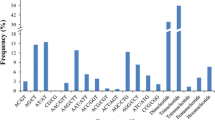Abstract
Expressed sequence tags (ESTs) are generated from single-pass sequencing of randomly picked cDNA clones and can be used for development of simple sequence repeat (SSR) markers or microsatellites. However, EST databases have been developed for only a small number of species. This paper provides a case study of the utility of freely available birch EST resources for the development of markers necessary for the genetic analysis of Betula luminifera. Based on birch EST data, primers for 80 EST-SSR candidate loci were developed and tested in birch. Of these, 59 EST-SSR loci yielded single, stable and clear PCR products. We then tested the utility of those 59 markers in B. luminifera. The results showed 28 (47.6%) yielded stable and clear PCR products for at least one B. luminifera genotype. In addition, this study describes a rapid and inexpensive alternative for the development of SSRs in species with scarce available sequence data.
Similar content being viewed by others
References
Adams MD, Kelley JM, Gocayne JD, Dubnick M, Polymeropoulos MH, Xiao H, Merril CR, Wu A, Olde B, Moreno RF, Kerlavage AR, McCombie WR, Venter JC. 1991. Complementary DNA sequencing: expressed sequence tag and human genome project. Science, 252: 1651–1656.
Becker J, Heun M. 1995. Barley microsatellites: allele variation and mapping. Plant Mol Biol, 27: 835–845.
Botstein D, White RL, Skolnick M, Davis RW. 1980. Construction of a genetic linkage map in man using restriction fragment length polymorphisms. Am J Hum Genet, 32: 314–331.
Brady SM, Provart NJ. 2009. Web-queryable large-scale data sets for hyposis generation in plant biology. American society of plant Biologist, in web http://www.aspb.org.
Don RH, Cox PT, Wainwright BJ, Baker K, Mattick JS. 1991. “Touchdown” PCR to circumvent spurious priming during gene amplification. Nucleic Acids Res, 19: 4008.
Fowler S, Thomashow MF. 2002. Arabidopsis transcriptome profiling indicates that multiple regulatory pathways are activated during cold acclimation in addition to the CBF cold response pathway. Plant Cell, 14: 1675–1690.
Gupta PK, Balyan IS, Sharma PC, Ramesh B. 1996. Microsatellites in plants: a new class of molecular markers. Curr Sci, 70: 45–54.
Li YC, Korol AB, Fahima T, Beiles A, Nevo E. 2002. Microsatellites: genomic distribution, putative functions and mutational mechanisms: a review. Mol Ecol, 11: 2453–2465.
Lu Yongquan, Wang Xusheng, Huang Weisu, Xiao Tianxia, Zheng Yan, Wu Weiren. 2006a. Development of amplified consensus genetic markers in Gramineae based on rice intron length polymorphisms. Scientia Agricultura Sinica, 39: 433–439. (in Chinese with an English abstract).
Lu Y, Ye Z, Wu W. 2006b. Analysis of the phylogenetic relationships among several species of gramineae using ACGM markers. Acta Genetica Sinica, 33: 1127–1131.
Murray MG, Thompson WF. 1980. Rapid isolation of high molecular-weight plant DNA. Nucleic Acids Res, 8: 4321–4325.
Pashley CH, Ellis JR, Mccauley DE, Burke JM. 2006. EST Database as a source for molecular markers: lessons from Helianthus. Journal of heredity, 97: 381–388.
Rong J, Bowers JE, Schulze SR, Waghmare VN, Rogers CJ, Pierce GJ, Zhang H, Estill JC, Paterson AH. 2005. Comparative genomics of Gossypium and Arabidopsis: unraveling the consequences of both ancient and recent polypolidy. Genome research, 15: 1198–1210.
Schuler GD. 1997. Sequence mapping by electronic PCR. Genome Res, 7: 541–550.
Toth G, Gaspari Z, Jurka J. 2000. Microsatellites in different eukaryotic genomes: survey an analysis. Genome Res, 10: 967–981.
Vos P, Hogers R, Bleeker M, Reijans M, Van de Lee T, Hornes M, Frijters A, Pot J, Peleman J, Kuiper M. 1995. AFLP: a new technique for DNA fingerprinting. Nucleic Acids Res, 23: 4407–4414.
Wang X, Zhao X, Zhu J, Wu W. 2005. Genome-wide investigation of intron length polymorphisms and their potential as molecular markers in rice (Oryza sativa L.). DNA Research, 12: 417–427.
Wei H, Dhanaraj AL, Rowland LJ, FU Y, Krebs SL, Arora R. 2005. Comparative analysis of expressed sequence tags from cold acclimated and non-acclimated leaves of Rhododendron catawbiense Michx. Planta, 221: 406–416.
Williams JG, Kubelik AR, Livak KJ, Rafalski JA, Tingey SV. 1990. DNA polymorphism amplified by arbitrary primers are useful as genetic markers. Nucleic Acid Res, 18: 6531–6535.
Yang L, Jin G, Zhao X, Zheng Y, Xu Z, Wu W. 2007. PIP: a database of potential intron polymorphism markers. Bioinformatics, 23: 2174–2177.
Author information
Authors and Affiliations
Corresponding author
Additional information
Foundation project: This work was funded by the Provincial Natural Science Foundation of Zhejiang in China (Y307465).
Rights and permissions
About this article
Cite this article
Lu, Yq., Li, Hy., Jia, Q. et al. Identification of SSR loci in Betula luminifera using birch EST data. Journal of Forestry Research 22, 201–204 (2011). https://doi.org/10.1007/s11676-011-0150-3
Received:
Accepted:
Published:
Issue Date:
DOI: https://doi.org/10.1007/s11676-011-0150-3




